Construction costs have ballooned 80%. Public transit and bike ridership remain stubbornly low. Two city-owned parking garages are shuttered. Across Portland, fatal car crashes last year reached the highest total in at least three decades.
Elected leaders have made addressing public drug use, homelessness and mental illness a top priority in downtown Portland. Less attention has been paid to boosting the transportation system in the central city.
As Portland passes the halfway mark on an ambitious plan meant to improve biking, transit and walking in the central city, some public transit advocates and local commuters question whether the city has sidelined its transportation goals as it addresses other issues downtown.
“It totally has fallen by the wayside,” Kiel Johnson, vice chair of BikeLoud PDX, a biking advocacy group, said of the city’s transportation efforts. “It just hasn’t been a big issue.”
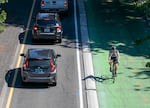
A bicyclist rides south in the Southwest Naito Parkway bike lane as cars drive in the opposite direction, downtown Portland, Ore., July 9, 2024. This lane, part of the Better Naito Parkway project, cost nearly $5 million and took seven years to complete but has been widely praised for increasing ease and safety of movement in the downtown area.
Anna Lueck / OPB
City officials disagree with the notion that transportation hasn’t been a priority. They say significant improvements have been made in the central city, an area that stretches from Goose Hollow through downtown to the Central Eastside, and from the South Waterfront north to Lower Albina.
“We’ve made a great, great deal of progress,” Millicent Williams, director of the Portland Bureau of Transportation, said in an interview with OPB. “You can see it all over the central city, but we know there’s more progress for us to make.”
In 2018, the Portland City Council adopted the Central City in Motion plan, which aimed to make it safer and easier to move around downtown. Through bike lanes, bus lanes, signals and other safety improvements, the plan sought to aid businesses and improve lives without worsening traffic congestion as jobs and population grew in the city’s urban core.
City officials backed the plan with fanfare but faced an immediate $9 million funding gap to make the slate phase of projects a reality. At the time, the bureau had not yet identified funding set aside for the projects, a bureau spokesperson said. But they had ideas for what would fund the more ambitious project list. Portland banked on Metro’s $7 billion region-wide transportation package for funding, but voters soundly defeated it in 2020.
Hannah Schafer, the bureau spokesperson, said it is “often the case” that bureau officials don’t identify a funding source prior to council approval. “They are high level documents that articulate a vision and a set of projects that would fulfill that vision,” Schafer explained in an email. “Once a plan is approved by City Council, the bureau can then pursue funding for specific projects within a plan.”
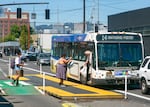
People cross the bike lane to board a TriMet bus on Southeast Hawthorne Boulevard, July 9, 2024. Hawthorne was modified to include parking-protected bike lanes and a bus and turn lane in summer 2021.
Anna Lueck / OPB
The Portland Bureau of Transportation is about six years into the 10-year project. Of the project’s 36 parts, the bureau has completed 13 and is working on six, according to a spreadsheet reviewed by OPB, detailing project costs and progress. City officials are still seeking funding to break ground on 17 more.
The city’s initial estimate for the project: $72 million. Its estimate now? $147 million.
Parts of the project have drawn widespread praise, including the Better Naito Parkway, a two-way bikeway and sidewalk along the west side of the Waterfront Park, which cost nearly $5 million and took about seven years to complete. At least one — a $17 million bike lane project along Southwest 4th Avenue — drew an unsuccessful challenge from the Portland Metro Chamber.
Mingus Mapps, the city commissioner who was in charge of the transportation bureau until Mayor Ted Wheeler took over earlier this month, was not available for comment.
During next year’s legislative session, lawmakers may take up a package that could revamp how the state funds its transportation system. That could involve new taxes or fees that raise hundreds of millions of dollars to fund basic maintenance and new projects. Members of the legislature’s Joint Transportation Committee are touring the state this summer to learn about what Oregonians want to see from such a package.
With more jobs and people than anywhere in Oregon, downtown Portland drives the state’s economy. But here — a city that was once a national leader for bike and transit infrastructure — about $62 million of the central city transportation project remains unfunded, and the city’s clean energy tax helped fill the transportation bureau’s $32 million budget gap this year.
“If we can’t bring this together in the central city, where can we bring this together?” said Sarah Iannarone, the executive director of the Street Trust, an advocacy group that focuses on and promotes safe streets.
One mom’s daily ride
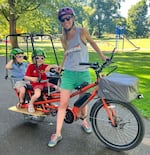
In this supplied photo, Melissa Kostelecky poses on her bike on July 8, 2024, with her children, Athena and Odin.
Courtesy of Chris Hale
Twelve years ago, Melissa Kostelecky, a 44-year-old Portland State University student, bought a bike. More recently, she began taking her two kids from her home on Portland’s east side to the International School of Portland, riding her bike along Southeast Clinton Street and crossing the Tilikum Crossing Bridge.
“It’s magical,” she said of her daily ride. “That bridge is just so pleasant to be on. The air is clean. It’s quiet. You can see the whole city. That’s kind of the highlight of my day.”
She would ride up about two blocks away from the school along South Water Avenue near Oregon Health & Science University. Then, as she put it: “It’s a bit of a hot mess.” Some cars used sidewalks to turn around and nearly backed up into her. The vehicle line to school stretched further and further. She watched as some people nearly got side-swiped.
“It’s chaos,” she said. “It’s uncomfortable to be around.”
Due to safety concerns, Kostelecky plans to enroll her kids in a different public school closer to home in the fall.
“Overall, Portland is a great place to bike, but ultimately those great facilities are not connected well,” she said. “It can very abruptly end and kind of dump you out into this really uncomfortable and sometimes dangerous situation.”
Concerns over central city
The pandemic upended life in many of America’s downtowns, forcing many people to stay and work from home. And by some metrics, Portland has been slower than most at returning to normal.
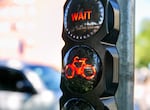
A traffic light alerts bicyclists to wait to cross Southwest Naito Parkway, in Portland, Ore., July 9, 2024.
Anna Lueck / OPB
Bike ridership increased by about 4.5% in the central city in 2023, according to the transportation bureau’s 2023 bicycle count. But that’s only after it had plummeted nearly 46% from 2019 to 2022.
The transportation bureau has not conducted a full-scale analysis of traffic congestion in the central city since the pandemic, Schafer, the bureau spokesperson, said in an email. Still, bureau officials say there are signs that traffic remains below pre-pandemic, pointing to a 12% decline in traffic counts on East Burnside near 16th Avenue from March 2019 to June 2024.
However, revenue from downtown parking meters has doubled since 2021, “which tells us that people are definitely returning to the central city, parking, and then walking to their destinations,” Schafer said.

A TriMet bus on line 19 to Woodstock drives through downtown Portland, Ore., June 29, 2024.
Anna Lueck / OPB
Public transit ridership across Portland’s central city is higher than the pandemic’s lowest point, but it remains far lower than in 2019, according to data provided to OPB. In downtown and the Lloyd District, ridership has declined for three consecutive years. But in the central city, “overall ridership is about 10% higher for May 2024 than it was last spring,” said Tyler Graf, a public information officer for TriMet.
“We’ve made up considerable ground over the past four years, a time when we’ve been working nonstop to restore ridership following the biggest single blow public transit has ever received,” Graf said in an email.
Yet some public transit advocates say that many people are opting to carpool rather than take the bus or light rail nowadays, in part due to infrequent stops and the agency’s decision to increase daily fares earlier this year for the first time in more than a decade. Sometimes, commuters say, nearly empty buses have left riders feeling unsafe downtown.
“We all need to get to where we need to go, safely and quickly, just like everybody else,” said Abby Griffith, coordinator of Bus Riders Unite!, who advocates for people with disabilities who rely on public transit like her. Griffith is blind.
City trudges ahead
So far, the city’s completed projects include a slew of protected bike lanes, extended bus lanes, high-visibility crossings for pedestrians and upgraded signals. The changes span from the Burnside Bridge to Southwest Broadway to Grand Avenue to Martin Luther King Jr. Boulevard to Southeast Hawthorne and more.
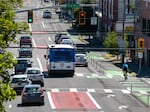
Dedicated bus and bike lanes on Southeast Hawthorne Boulevard in Portland, Ore., July 9, 2024. Hawthorne was modified, adding parking, bike and bus lanes, and turn lane, in summer 2021.
Anna Lueck / OPB
Now, the city is tackling some of its most expensive projects, including reconstructing and repaving Southwest 4th Avenue and safety improvements, such as shortened crossings and protected bike lanes, on Northeast Broadway and Northeast Weidler. Combined, those projects are estimated to cost $59 million.
Bureau officials said they have faced challenges making progress on the plan, from navigating the pandemic to finding the funding sources necessary to complete projects. Meanwhile, construction costs ballooned 80%, in part due to inflation and additional upgrades from safety improvements, such as replacing aging streetlights to updating old traffic signals, said Gabe Graff, project manager for the Central City in Motion plan.
“I can understand a fair amount of frustration about thinking, ‘We’re not where we would like to be,’” said Williams, director of the city’s transportation bureau. “We’re not where we would like to be ourselves. We always want to be able to do more … It’s not because of lack of desire or trying. It really is a funding issue.”
Williams acknowledged that work-week travel habits have changed significantly downtown, noting that office buildings haven’t returned to full capacity since the pandemic. But during the evenings and weekends, she said, “It’s pretty busy.” Williams disputed the notion that the city has slowed its transportation efforts, pointing to investments from the mayor’s office and voters’ three approvals of a city gas tax.
During next year’s legislative session, Williams said the bureau will be advocating for basic funding for maintenance and operations, including funds for road repair. She said those funds and accruing support from policymakers will be key to helping the city reach its potential as a transportation hub.
“People can see the Portland that they recall,” Williams said. “We’re still here though. We just need a little more money — or a lot.”




